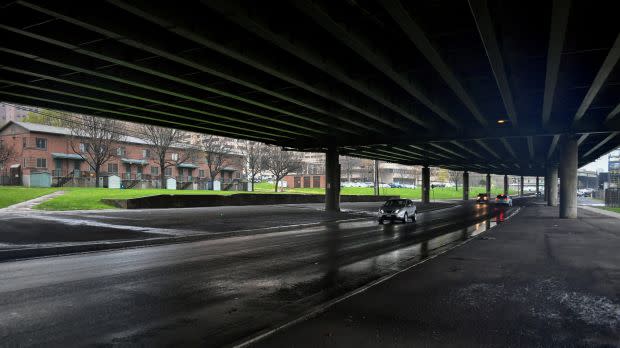Pete Buttigieg just defined infrastructural racism
- Oops!Something went wrong.Please try again later.
- Oops!Something went wrong.Please try again later.

On Monday (Nov. 8), US transportation secretary Pete Buttigieg offered details about plans in the just-passed $1 trillion infrastructure bill to rectify harm from highway construction throughout the 20th century. Racism, he argued, had defined aspects of US highway and urban design for decades.
To illustrate the point, Buttigieg referenced the construction of the Jones Beach parkways in New York City in the 1920s. “If an underpass was constructed such that a bus carrying mostly Black and Puerto Rican kids to a beach…in New York was designed too low for it to pass by,” he said at a press conference, “that obviously reflects racism that went into those design choices.”
Some reactions online decried the idea as outlandish, but Buttigieg was drawing from historical evidence amassed by journalist Robert Caro in his biography of Robert Moses, known as New York City’s “master planner,” in The Power Broker. Moses led an urban renewal movement that took hold in the postwar US and used physical infrastructure as a way to separate wealthy, majority-white communities in and around cities from largely low-income Black and Latino areas. New roads and highways constructed in this era often benefited white neighborhoods while they divided and destroyed poor neighborhoods of color: Atlanta, Detroit, and Houston among them.
Racist motivations in US highway construction
Moses’s career spanned 44 years overseeing the design of many of the city’s midcentury highways, bridges, parks, and public housing developments. According to Caro, Moses had the overpasses leading to Jones Beach built low enough that cars—more likely to be owned by white families—could get through, but not buses, which served lower-income people of color. Some recent historians have called this particular story into question, but racist attitudes also showed up in Moses’s approach to highway construction, for which he is most famous (or infamous). Moses oversaw the creation of more than a dozen expressways in New York City, and is blamed for destroying numerous Black and Latino communities in the process.
In this, though, Moses was not alone. The great boom in US highways throughout the 1950s and 60s came at the expense of communities of color in nearly every major city in the country. In all, more than 1 million Americans were displaced from their homes throughout the creation of the US interstate highway system, according to former transportation secretary Anthony Foxx. Sometimes this was done purposefully by urban planners, but often, building a highway through the heart of a disenfranchised community was simply the easiest thing to do. Without much economic or political power, these residents couldn’t put up a fight. The result more than half a century later is a series of communities that are polluted, disjointed, and cut off from public transportation.
The Biden administration’s plan to reconnect communities
The Reconnecting Communities Act included in the bipartisan infrastructure bill allots $1 billion to projects related to restoring and communities torn apart by highways. It’s a far cry from the $20 billion originally proposed, but is still the first time federal dollars have been put towards this type of restorative justice.
In the Nov. 8 press conference, Buttigieg offered little detail on exactly how the money will be spent, but presumably much of it will go towards highway removal projects. This is something that’s already being done in at least 18 US cities. For those places where removal isn’t possible, he suggested that community reconnection could be achieved by “building across” highways, with roads or land bridges to connect neighborhoods that have been split. Buttigieg emphasized the importance of heeding the voices of local residents in whatever solutions are developed.
Sign up for the Quartz Daily Brief, our free daily newsletter with the world’s most important and interesting news.
More stories from Quartz:
Seoul will be the first city government to join the metaverse
A surge in the US affordable housing supply is coming from people who can’t afford their homes
